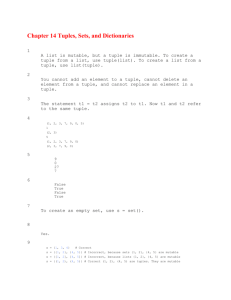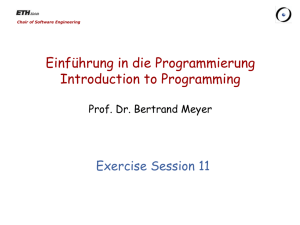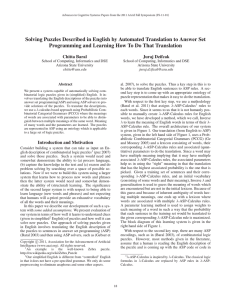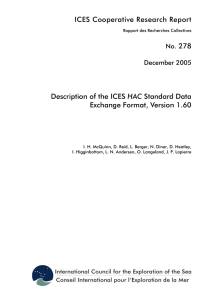object
advertisement
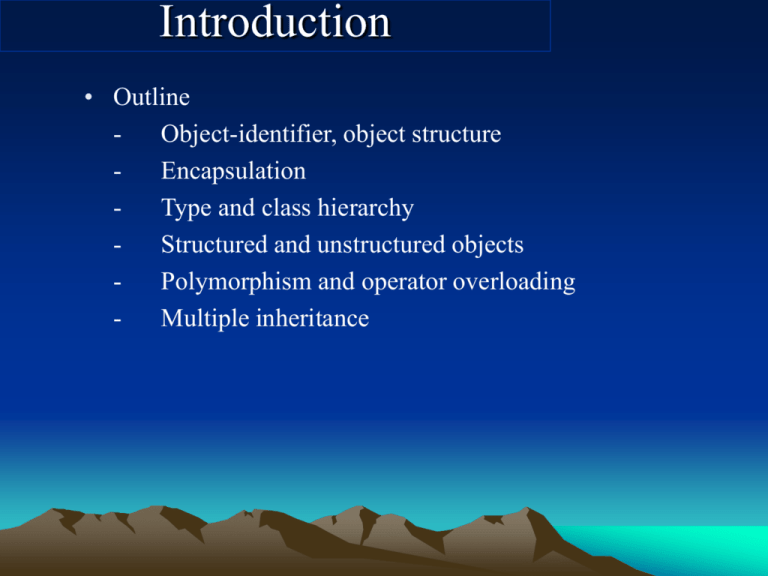
Introduction
• Outline
Object-identifier, object structure
Encapsulation
Type and class hierarchy
Structured and unstructured objects
Polymorphism and operator overloading
Multiple inheritance
Introduction
• OO has roots in Programming languages
• SIMULA (simulation language) has the concept of
classes - late 60s
• SMALL TALK is the first pure OO language
• Hybrid languages incorporate OO concepts into an
already exisiting programming language
– Example: C++
Introduction
• Programming objects only exist during the program
execution
• Database objects need to exist permanently
(persistent objects)
• Concepts such as encapsulation, inheritance, identity
and evolving relationships must be applied in the
context of OODBMS
• OODBMS must also support transactions,
concurrency, recovery
Object Identity
Each object in the DB has a unique identity (OID)
even though the value of an object changes, its identity
must not change (the OID is immutable)
if an object is deleted its OID must not be assigned to
any other object
These two properties imply that an object identifier must not
depend on an attribute
Some systems use the physical address of the object in
storage as an OID
Relational database tables have a primary key
value can change
could have same object - two tables - different primary
keys
Object Structure
• In OODB, the value of a complex object can be
constructed from other objects
• Each object can be viewed as a triple
– ( i, c, v)
– where i is the unique object identifier (OID)
– c is the constructor or an indication of how the object
value is constructed (operator)
– v is the value of the object (state)
• Basic constructors are atom, tuple, set
– Others: list, array
Object Structure
• The value v can be interpreted on the basis of the
constructor c
• Example:
– if c = atom then v = atomic value
o1 = (i1, atom, Houston)
o2 = (i2, atom, Bellaire)
o3 = (i3, atom, Sugarland)
o4 = (i4, atom, 5)
o5 = (i5, atom, Research)
o6 = (i6, atom, 22-May-78)
The value ‘Houston’
Object Structure
• Example:
– if c = tuple then v = < a1:i1..an:in >
o8 = (i8, tuple, < dname:i5, dnumber: i4, mgr: i9,
locations:i7, employees:i10, projects: i11>)
o9 = (i9, tuple, < manager:i12, managerstartdate: i6>)
Object Structure
• Example:
– if c = set then v = {i1,i2,i3}
o7 = (i7, set, { i1, i2 , i3 } )
o10 = (i10, set, { i12, i13 , i14 } )
o11 = (i11, set, { i15, i16 , i17 } )
Type Constructors
Define type employee
tuple(
name
ssn
birthdate
work_in
string
string
date
department )
Define type department
tuple(
dname
dnumber
mgr
locations
employees
projects
string
integer
tuple ( manager
startdate:
set (string)
set (employee )
set (project ) )
We will have references
to other objects
employee
date)
Type Constructors
O8
Dname
atom
i5
Research
atom
dnumber
i4
tuple
mgr
tuple
locations
i9
set
employees
projects
i10
5
Manager managerstartdate
atom
i6
22-May-78
tuple
i12
tuple
i13
tuple
i14
Encapsulation
• Encapsulation - Structure of an object is not visible to the
external world
– all operations on an object are predefined
– some operations may be used to create, destroy, modify
the values or retrieve the values of an object
– External users only have access to the interface of the
object (signature) which defines the names and types of
all parameters to each operation
– Methods specify the implementation of operations
– A method is invoked (call) by sending a message
Encapsulation
• In a RDBMS, the structure of an object is visible to all
users
– That is, a relation and attributes are visible
– All database operations (selection, insertion,
deletion..) are applicable to any relation (all object
types)
• In an OODBMS, one can divide a structure into visible
and hidden parts
– The hidden attributes are completely encapsulated
and accessed only through pre-defined operations
Encapsulation/Persistence
• It is customary for an OODBMS to be closely coupled
with an OO programming language
• An OO programming language is used to specify the
method implementations
– O2 uses O2C … O2C is C adapted for objects
– ObjectStore uses C++
• In an OODBMS, not all objects are persistent; some are
transient
• In an EER or relational model, all objects are persistent
Type and Class Hierarchies
Types are different from classes even though they lead to
the same structures
A type has a name, a set of attributes (instance variables)
and operations (methods)
A new type can be defined based on other predefined
types leading to a Type hierarchy
An object can belong to a type
Type definitions do not generate objects of their own
Example: Person: Name, Address, Birthdate, Age
Employee subtype of Person: Salary, HireDate
Class Hierarchies
Class is a collection of objects meaningful to some
application
In most OODBs, a class is a collection of objects
belonging to the same type
A class is defined by its name and the collection of
objects included in the class
We can also define subclasses and superclasses creating a
class hierarchy
In OODBs the concept of a type and class are the same.
Hence, the hierarchies are the same.
Each class then has a particular type and holds a
collection of persistent objects of that type
Complex Objects
Motivation for the development of OO systems is to
represent complex objects
Two types of complex objects:
Unstructured
Structured
Complex Objects
Unstructured Complex Object
– The structure of these objects is not known to the
DBMS
– Only the application programs can interpret the
objects
– Ex: Bitmap images - BLOB (Binary large objects)
– These objects require a large amount of storage and
not a part of the standard type definitions
Complex Objects
Unstructured Complex Object
– DBMS may retrieve only a portion of the object
– DBMS may use caching and buffering to prefetch portions
of the object
– The DBMS does not have the capability to directly
process selection conditions based on values of these
objects unless the application programs provide the code
– In OODBMS, this is done by defining an Abstract data
type with operations for selection, comparison, etc
– These feature allows the OODBM to have an extensible
type system
• That is, new types can be created and hence libraries of
new types
Complex Objects
Structured Complex Object
– The object structure is defined and known to the
DBMS
– Object Structure is defined using type constructors
(set, atom, tuple)
– Two types of reference semantics exist between a
complex object and its component:
Ownership
Reference
Complex Objects
Ownership Semantics
– Subobjects are encapsulated within a complex object
are considered a part of the complex object
Reference Semantics
– Components of a complex object are themselves
independent objects, but at the same time may be
considered a part of the complex object
O8
Dname
Research
dnumber
5
tuple
mgr
tuple
locations
i9
set
employees
projects
i10
Manager managerstartdate
atom
i6
22-May-78
tuple
i12
tuple
i13
tuple
i14
Complex Objects
The ownership semantics leads to an
is-part-of or is-component-of relationship
are employees part of the department?
The is-part-of relationship (or ownership semantics) means
that the encapsulated objects can be accessed by the
methods of that object and deleted if the object is deleted
Complex Objects
The reference semantics leads to an
is-associated-with relationship
are the employees associated with the department?
An OODBMS should provide the storage options for
clustering the component objects together in order to
increase efficiency
The mechanism of building objects from complex object
structures is called object assembly
Other OO concepts
Polymorphism
– An operator can be applied to different types of
objects
– When an operator has distinct implementations then
we have operator overloading
– Example: + when applied to integers implies integer
addition
– + when applied to sets implies set union
Other OO concepts
Polymorphism
Example:
Geometry_Object: Shape, Area, CenterPoint
• Rectangle subtype_of
Geometry_Object(Shape=‘rectangle’): Width, height
• Triangle subtype_of
Geometry_Object(Shape=‘triangle’): side1, side2, angle
• Circle subtype_of Geometry_Object(Shape=‘circle’):
Radius
Area is a method that would be different for each sub-Type
Other OO concepts
Strongly Typed systems:
Method selection is done at compile time (early binding)
Weakly Typed systems:
Method selection is done at run time (late binding).
Lisp and Small Talk are examples late-binding
Other OO concepts
Multiple Inheritance:
allowed in O2
leads to a lattice
– One problem: if a subtype inherits two distinct methods
with the same name from two different supertypes
– A solution: check for ambiguity when the subtype is created
and let the user choose the function
– Another solution: use some system default
– A third solution: disallow multiple inheritance if ambiguity
occurs
Other OO concepts
Selective Inheritance:
– When a subtype inherits only a few methods
– This mechanism is not usually provided by OODBMS
Other OO concepts
Versions:
– Ability to maintain several versions of an object
– Commonly found in many software engineering and
concurrent engineering environments
– Merging and reconciliation of various versions is left to
the application program
– Some systems maintain a version graph
Configuration:
– A configuration is a collection compatible versions of
modules of a software system (a version per module)



